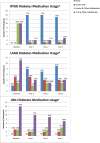Three-Year Outcomes of Bariatric Surgery vs Lifestyle Intervention for Type 2 Diabetes Mellitus Treatment: A Randomized Clinical Trial
- PMID: 26132586
- PMCID: PMC4905566
- DOI: 10.1001/jamasurg.2015.1534
Three-Year Outcomes of Bariatric Surgery vs Lifestyle Intervention for Type 2 Diabetes Mellitus Treatment: A Randomized Clinical Trial
Abstract
Importance: Questions remain about the role and durability of bariatric surgery for type 2 diabetes mellitus (T2DM).
Objective: To compare the remission of T2DM following surgical and nonsurgical treatments.
Design, setting, and participants: In this 3-arm randomized clinical trial conducted at the University of Pittsburgh Medical Center from October 1, 2009, to June 26, 2014, in Pittsburgh, Pennsylvania, outcomes were assessed 3 years after treating 61 obese participants aged 25 to 55 years with T2DM. Analysis was conducted with an intent-to-treat population.
Interventions: Participants were randomized to either an intensive lifestyle weight loss intervention for 1 year followed by a low-level lifestyle intervention for 2 years or surgical treatments (Roux-en-Y gastric bypass [RYGB] or laparoscopic adjustable gastric banding [LAGB]) followed by low-level lifestyle intervention in years 2 and 3.
Main outcomes and measures: Primary end points were partial and complete T2DM remission and secondary end points included diabetes medications and weight change.
Results: Body mass index (calculated as weight in kilograms divided by height in meters squared) was less than 35 for 26 participants (43%), 50 (82%) were women, and 13 (21%) were African American. Mean (SD) values were 100.5 (13.7) kg for weight, 47.3 (6.6) years for age, 7.8% (1.9%) for hemoglobin A1c level, and 171.3 (72.5) mg/dL for fasting plasma glucose level. Partial or complete T2DM remission was achieved by 40% (n = 8) of RYGB, 29% (n = 6) of LAGB, and no intensive lifestyle weight loss intervention participants (P = .004). The use of diabetes medications was reduced more in the surgical groups than the lifestyle intervention-alone group, with 65% of RYGB, 33% of LAGB, and none of the intensive lifestyle weight loss intervention participants going from using insulin or oral medication at baseline to no medication at year 3 (P < .001). Mean (SE) reductions in percentage of body weight at 3 years were the greatest after RYGB at 25.0% (2.0%), followed by LAGB at 15.0% (2.0%) and lifestyle treatment at 5.7% (2.4%) (P < .01).
Conclusions and relevance: Among obese participants with T2DM, bariatric surgery with 2 years of an adjunctive low-level lifestyle intervention resulted in more disease remission than did lifestyle intervention alone.
Trial registration: clinicaltrials.gov Identifier: NCT01047735.
Figures




Comment in
-
Bariatric Surgery vs Lifestyle Intervention for Type 2 Diabetes Mellitus.JAMA Surg. 2015 Oct;150(10):940. doi: 10.1001/jamasurg.2015.1542. JAMA Surg. 2015. PMID: 26132502 No abstract available.
-
Mass Treatment With Bariatric Surgery for Type 2 Diabetes Mellitus.JAMA Surg. 2016 Feb;151(2):196-7. doi: 10.1001/jamasurg.2015.3405. JAMA Surg. 2016. PMID: 26465788 No abstract available.
-
Mass Treatment With Bariatric Surgery for Type 2 Diabetes Mellitus--Reply.JAMA Surg. 2016 Feb;151(2):197. doi: 10.1001/jamasurg.2015.3408. JAMA Surg. 2016. PMID: 26466125 No abstract available.
-
Bariatric Surgery for Type 2 Diabetes: Getting Closer to the Long-term Goal.JAMA. 2016 Mar 22-29;315(12):1276-7. doi: 10.1001/jama.2016.1884. JAMA. 2016. PMID: 27002449 Free PMC article. No abstract available.
References
-
- Buchwald H, Estok R, Fahrbach K, et al. Weight and type 2 diabetes after bariatric surgery: systematic review and meta-analysis. Am J Med. 2009;122(3):248–56e245. - PubMed
-
- Rubino F, Schauer PR, Kaplan LM, Cummings DE. Metabolic surgery to treat type 2 diabetes: clinical outcomes and mechanisms of action. Annu Rev Med. 2010;61:393–411. - PubMed
Publication types
MeSH terms
Associated data
Grants and funding
LinkOut - more resources
Full Text Sources
Other Literature Sources
Medical
Research Materials

